Like a Rorschach ink-blot test, the old Hyundai Sonata looked like different things to different people. “Youthful,” said some. “An anti-Camry,” said others. “Attention getting,” agreed many. “Overwrought and ugly,” opined a significant few.
Well, not anymore. Because while Hyundai chose to get noticed when it introduced its sixth-generation Sonata to the North American market in 2011, turning out a car whose “Fluidic Sculpture” styling was all swoopy curves and prominent creases with a big upswept chrome grille, for the seventh-generation 2015 Sonata things have changed. Now, it seems, the Korean-based manufacturer has decided that the key to getting ahead of the top-selling Toyota Camry, Ford Fusion and Honda Accord in the crowded mid-size sedan market is to ease back on the styling statement and go with a more conservative, grown-up appearance.
Hyundai calls the new style “Fluidic Sculpture 2.0” and says it encapsulates a trio of main design elements: fluid aesthetics, the “modern Hyundai look”, and a premium ambiance. Translation? The new Sonata still has a hint of the old Sonata’s flowing lines, but overall it has moved decidedly towards the mainstream. So no, it’s not the anti-Camry anymore (well actually, maybe it is, since the Camry has gone the other way and adopted an aggressive gaping grille for 2015, but I digress).
Hyundai says its new design philosophy is adaptable to a wider variety of vehicle types and sizes, and certainly you could argue that the new Sonata does bear a striking resemblance to Hyundai’s upscale new Genesis full-size sedan. If you were cynical, however, you could argue that it also looks exactly like what you’d get if you blended together the latest Toyota Camry, Ford Fusion and Honda Accord, and reconstituted them into a single new car. Not that there’s anything wrong with that.
My test car was Hyundai’s top-of-the line Ultimate 2.0T model, which combines all the performance-oriented features of the Sonata Sport 2.0T with most of the luxury features of the Sonata Limited. It adds up to a genuinely impressive level of equipment for a car that lists at $36,494 destination included (and not counting a $1,614.86 price adjustment that the manufacturer was showing on its website at the time of writing).
Highlights in the Ultimate 2.0T include dual-zone air conditioning, leather upholstery, heated and ventilated power-adjustable front sport seats, heated rear seats, eight-inch touchscreen navigation system with rear-view camera, nine-speaker Infinity audio system with satellite radio, keyless entry with alarm, push-button start, blind-spot information system, lane departure warning system, front collision warning system, adaptive cruise control, electric parking brake with auto function, panoramic sunroof, alloy pedals, built-in rear sunshade blinds, 18-inch alloy wheels (even base models get alloys), hands-free smart trunk, and a bunch of sport-specific exterior trim including a more aggressive front grille, rocker panel extensions, trunk lip spoiler, rear diffuser, dual twin-tip exhaust, and chromed side moulding. There’s a whole lot more besides, but I don’t want to bore you with the full equipment list. Suffice to say there’s little lacking except perhaps a heated steering wheel, which shows up in the Limited but not the Ultimate (it gets a fat, flat-bottomed sport steering wheel, but it’s not heated — go figure).
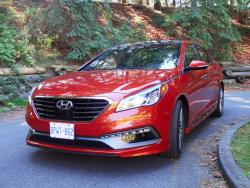 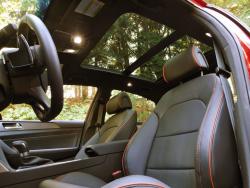 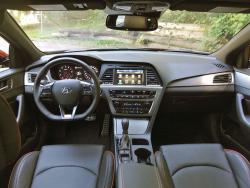 2015 Hyundai Sonata Ultimate 2.0T, sunroof, dashboard. Click image to enlarge |
Under the hood, where lower trim levels get a naturally-aspirated 2.4L direct injected four-cylinder engine, the Sonata 2.0T gets a turbocharged 2.0L four-cylinder powerplant that Hyundai claims offers the power of its competitors’ six-cylinder engines with fuel efficiency befitting a four-cylinder. This engine is essentially carried over from the previous-generation car but with a significant revision: it now has a smaller turbocharger, which improves low-end responsiveness (and fuel efficiency) at the cost of some high-end oomph (the little turbocharger simply runs out of steam at high rpm). Getting the power to the front wheels is a six-speed automatic transmission with paddle shifters.
For those who like numbers, the 2.0L turbo previously churned out 274 horsepower and 269 lb-ft of torque, and now manages 245 horsepower and 260 lb-ft (versus 185 horsepower for the 2.4L engine). The nice thing is that the torque comes on quickly, from 1,350 rpm onward, so for those who prefer seat-of-the pants evaluations the revised powerplant comports itself well, launching off the line with good authority and a discreetly snorty exhaust note, hitting 100 km/h in a touch over eight seconds (versus seven seconds for the previous generation version). In city and suburban driving most drivers won’t likely miss the lost horsepower because the initial launch feels as quick as ever — perhaps even quicker — but on highway grades and on-ramps the engine noticeably lacks the grunt of its V6 competitors.
The transmission is competent if perhaps a bit unremarkable: it performs its duties quietly in the background when run in automatic mode, but in manual shift mode there’s far too much lag between when you click the shift paddle and when the shift actually executes. On the other hand, if you decide to make a run for the redline the transmission will take over and shift about 700 rpm before you get there.
In addition to improved low-end response the revised turbocharged nets slightly better fuel economy, although this might not be immediately apparent due to the changeover in Canada from two-cycle testing in 2014 to five-cycle testing for 2015 models. The new 2015 Sonata 2.0T is rated 10.4/7.4 L/100 km (city/highway) under the five-cycle test, while the 2014 Sonata 2.0T rated 10.0 / 6.3 L/100 km using the old two-cycle test. A better comparison would be to look at the 2014 U.S. model’s five-cycle EPA ratings, which worked out to 11.2/7.4 L/100 km. Using this comparison, the new car gets about seven percent better fuel economy in city driving and scores the same as before on the highway.
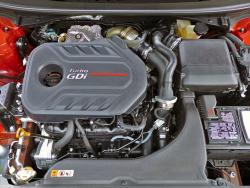 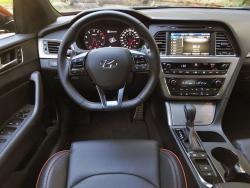 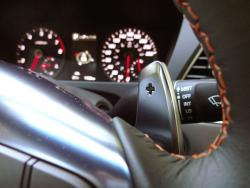 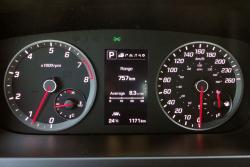 2015 Hyundai Sonata Ultimate 2.0T engine bay, driver’s seat, paddle shifter, gauges. Click image to enlarge |
My own real-world driving bears these numbers out reasonably closely: I averaged 9.6 L/100 km during a week of mixed driving, with a worst-recorded single trip number of 13.6 L/100 km and a best-recorded result of 8.3 L/100 km.
On the road, the Sonata proved to be a pleasant and comfortable conveyance, although even in Ultimate 2.0T trim it isn’t really as sporty as all that. Hyundai has vastly improved steering feel across the range as of late, and the Sport and Ultimate models benefit further from a rack-mounted power steering system (as opposed to the standard column-mounted power assist), with the result that the Ultimate 2.0T’s steering is now entirely on-par with others in the segment, maybe even better than some. But while it is precise and responsive enough, it still lacks a little in heft and feedback, even in sport mode (you can cycle through Normal, Eco and Sport drive modes using a button on the console, with each mode adjusting the steering effort, throttle response and shift programming accordingly). The chassis, for its part, exhibited perfectly competent road manners and handling, at least at the sort of speeds one is restricted to on public roads.
A noteworthy innovation is the electric park brake’s auto-hold feature, something I’d not seen before. When you engage the auto-hold feature, then any time you come to a full stop the park brake sets itself and holds the car until you step on the gas, relieving the driver of the need to keep their foot on the brake. I guess it could be handy if you’re stuck in stop-and-go traffic with a sore foot, but I found the effect a bit peculiar and so I didn’t use for long.
Inside, the new Sonata is amply spacious — big enough, in fact, that despite occupying the mid-size rung in Hyundai’s lineup it actually counts as a full-size car according to official U.S. measures. I found the front sport seats entirely comfortable for my 5’11” frame, and the back seat is likewise a pleasant place to be, with generous legroom (an inch more than the outgoing model) and adequate headroom for folks up to about six feet (I fit with a little to spare). The trunk is a generous 463L, and Hyundai’s smart trunk feature provides hands-free opening without having to wave your foot under the bumper (if the system is enabled then the trunk will automatically open if you stand close to the back of the car for more than three seconds with the key in your pocket. You can turn the system off, but three seconds seems to be about the right timeframe — I never had the trunk open itself needlessly).
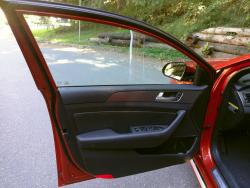 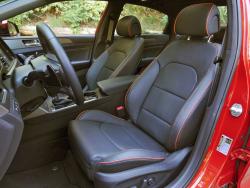 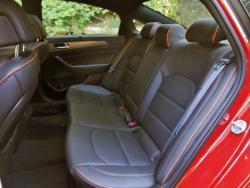 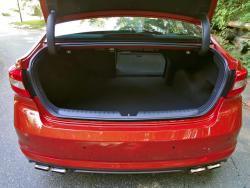 2015 Hyundai Sonata Ultimate 2.0T driver’s door, seating, trunk. Click image to enlarge |
The interior materials are all up to snuff, with soft-touch door uppers both front and back, a soft-touch dash topper, and nice textures where appropriate. Rigid plastics are used for the console and door lowers, as expected in this segment, and also for the instrument binnacle. Overall, Hyundai has clearly expended some effort to create an upscale look and feel, as evidenced by the colour-keyed stitching in my test car, the precision switchgear, and the just-right sheen of the Ultimate 2.0T’s metallic trim inlays. Show someone a photograph of the centre stack and I’ll wager they guess it’s a photo from a premium German marque (as an aside, I’ve read complaints that the upper and lower portions of the stack are slightly offset from each other, but this design element isn’t something you notice at all when you’re in the car — everything looks just right from the driver’s seat). The Sonata is quiet inside, too, thanks to abundant new sound-deadening materials compared to the outgoing model.
My list of complaints is short: First, the new car still has pretty obstructive A-pillars. This is something I’ve complained about with previous Sonatas, and I was really hoping they’d slim the pillars down in the latest version. Second, the Bluetooth connectivity doesn’t seem as robust as most: it connected to my older phone only with difficulty, and other people have complained that the system doesn’t play well when trying to stream music from iPhones (this is software driven so it will likely get addressed in due course, but in the meantime it’s worth confirming that the system successfully supports all the features you require on your particular phone). Third and last, I found the blind-spot information system a little oversensitive. This is a pretty minor issue, but it’s a bit disconcerting to get beeped at when making a perfectly safe and well-planned lane change in congested traffic, and it may discourage signalling (given that the blind-spot information system doesn’t beep if you don’t signal).
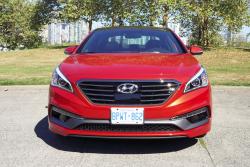 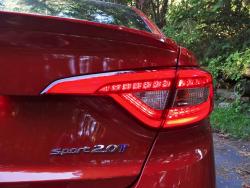 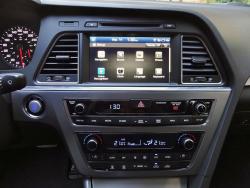 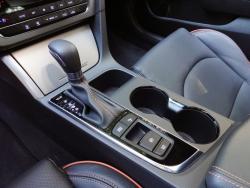 2015 Hyundai Sonata Ultimate 2.0T, taillight, setup menu, shifter. Click image to enlarge |
Those little issues aside, I like the 2015 Sonata Ultimate 2.0T. Despite the “Sport” insignia on its trunk lid it’s not the sportiest of family sedans (you might want to check out the Mazda6 or Chrysler 200 if that’s what you really prize), and lack of all-wheel drive capability means it’s not the most go-anywhere family sedan either (look to the Ford Fusion, Subaru Legacy or Chrysler 200 for this). Among the all-rounders, however, it stands tall. It’s a well thought-out machine that raises the bar in terms of features, technology and driving dynamics, and wraps it all up in a style that’s perhaps less distinctive than the previous Sonata, but that exudes an upscale new sense of sophistication. At $25,694 (destination in) for the base 2.4L GL, the Sonata already offers a compelling value proposition, and the loaded Ultimate 2.0T ($36,494 destination in) takes that same value proposition into near-premium territory, with a wide array of high-end features and conveniences.
|
Manufacturer’s Website: Hyundai Canada Photo Gallery: Crash Test Results: |
Pricing: 2015 Hyundai Sonata Ultimate 2.0T
Base price: $34,799
Options: None
Freight: $1,695
A/C tax: $100
Price as tested: $36,594
Competitors:
Chevrolet Malibu
Chrysler 200
Ford Fusion
Honda Accord
Kia Optima
Mazda6
Nissan Altima
Subaru Legacy
Toyota Camry
Volkswagen Passat
















